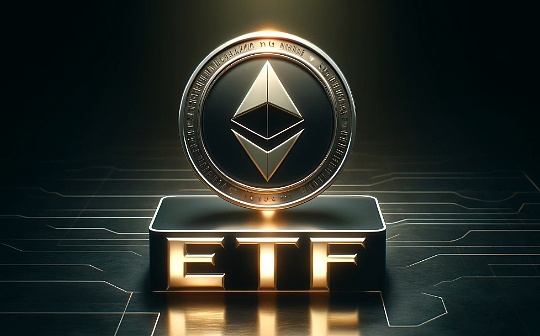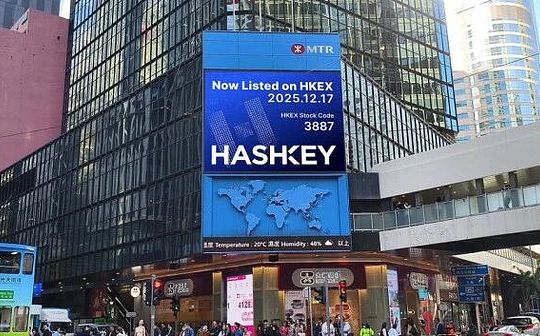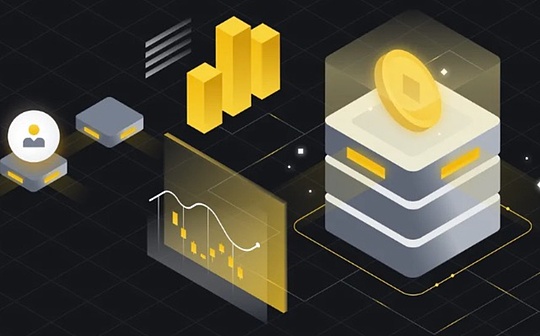
Written article: AC-Core, YBB Capital Researcher
Foreword
According to the definition of Ethereum Foundation, Layer2 = rollup in Ethereum.According to the recent new view of Vitalik, if other EVM chains use non -Ethereum as DA (Data availability), then it is the Ethereum ValidiumThe integrity of diplomatic is easy).Although the current DA problem, there is still a certain degree of controversy about the precise definition of Layer2, but the upgrade route of Taifang is still centered on Rollup, and DA is the preservation or uploading Rollup transaction data in Ethereum upgrade in Ethereum upgrade.Important role.Whether Optimistic Rollup and ZK Rollup can access related data through DA will affect their own security to a certain extent, even if their dependence is different.Faced with COSMOS shared security innovation and Celestia’s DA penetration, as well as market merchants in the market, can EIGENLAYER from the native Ethereum be rejected the market by raising the middleware to the Ethereum level security narrative.sovereignty?
Eigenlayer
>
Picture source: EIGENLAYER White Paper
Simple understanding, Eigenlayer is a Re-Staking agreement based on Ethereum to provide Ethereum level security for the entire Ethereum encrypted economic system in the future.It allows users to re -pledge native ETH, LSDeth and LP Token through Eigenlayer smart contracts and get verification rewards to allow third -party projects to enjoy more reward benefits while enjoying ETH’s main network security, thereby achieving win -win results.
The reason why Ethereum can attract a large amount of transaction volume and liquidity is because it is the safer first -level blockchain that is currently recognized by most people.EIGENLAYER is directly connected to Ethereum’s security and liquidity by active verification service.Business), this process is called re-stronging.This article only gives the first AVS project developed by the EIGENLAYER team: EIGENDA.
EIGENDA: Rollup data availability
>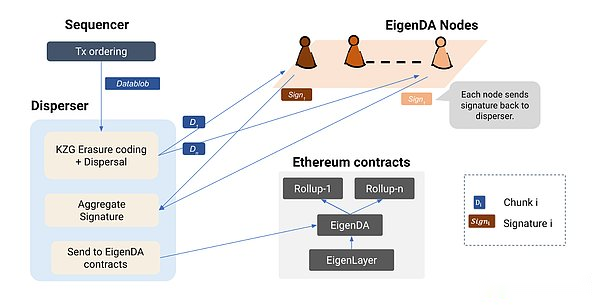
Picture source: EIGENDA official
According to the official interpretation and introduction (no actual related data is supported), EIGENDA is a decentralized data availability (DA) service built on EigenLayer Restaking on the Ethereum, and will be the first active verification service on EIGENLAYER (AVS).Among them, RESTAKERS can entrust the pledge to execute EIGENDA and node operators who perform verification tasks to obtain service fees in return, and RollUps can publish data to EIGENDA, thereby reducing the cost of transaction costs, obtaining higher transaction throughput and improving the entire entire.EIGENLAYER ecosystem security.The security and transaction throughput in this development process will expand with the amount of pledge, related ecological agreements, and the overall development of operators.
EIGENDA aims to provide Rollups with innovative DA solutions, so that Ethereum pledges and verificationrs can improve their security by connecting each other and achieve the purpose of reducing costs under the premise of increasing throughput.The degree ofization will adopt multiple nodes.According to EIGENDA tweets, the Layer2 solution that has been integrated now includes CELO from L1 to Ethereum L2; Mantle and its supporting products outside the BitDao ecosystem; providing FLUENT on the ZKWASM execution layer; offShore at the MOVE execution layer, and the MOVE execution layer, and the MOVE execution layer of the OFFSHORE, andOP Stack in Optimism (used at the EIGENDA test network).
EIGENDA is a safe, high throughput and decentralized data availability (DA) service built on Ethereum, which is developed based on Eigenlayer Restaking.The following is some key features and advantages designed for EIGENDA to achieve:
characteristic:
Sharing security: EIGENDA uses Eigenlayer’s shared security model to enable the verifications to participate in the verification process through contributing ETH to improve the overall security of the network;
Data usability: The main goal of EIGENDA is to ensure data availability on the Layer 2 network.It verifies and ensure the validity of the data of the Rollup network by verifying and ensuring the effectiveness of the Rollup network, preventing bad behaviors and ensuring the normal operation of the network;
Decentralized sorting: EIGENDA uses EIGENLAYER’s decentralized sorting mechanism to ensure that the transactions in the ROLLUP network are executed in the correct order, thereby maintaining the correctness and consistency of the entire system;
Flexibility: EIGENDA’s design allows L2 developers to adjust various parameters as required, including weighing between security and activity, pledged token model, and deletion coding ratio to meet different scenarios and needs.
Advantages:
Economic benefits: EIGENDA realizes ETH sharing security through Eigenlayer, thereby reducing potential pledge costs.It reduces the operating cost of each operator through decentralized data verification work, provides more economical and efficient verification services;
High throughput: EIGENDA is designed with horizontal scalability. As more operators join the network, their throughput will increase.In private tests, EIGENDA showed a throughput of up to 10 MBPS and has a roadmap that expand to 1 GBPS, which provides possibilities for the application of high -bandwidth demand, such as multiplayer games and video streams;
Security mechanism: EIGENDA uses a multi -layer security mechanism, including the sharing security of Eigenlayer, the Proof of Custody mechanism, and Dual Quorum to ensure the security, decentralization and anti -examination of the network;
Customistity: EIGENDA provides flexible design that allows L2 developers to adjust various parameters according to their specific needs and use cases to find balance between safety and performance.
Re -pledge mode
>
Picture source: Delphi Digital
Native ETH retired:
For independent ETH pledges, they can point the pledged ETH to the EIGENLAYER smart contract through the withdrawal voucher to re -pledge and obtain additional benefits.If the independent pledgers have improper behavior, Eigenlayer can directly punish its withdrawal voucher;
Lst again:
LST (Liquid Staking Token) is the abbreviation of liquid pledged token.Ordinary investors, even if there are no 32 ETHs, they can also “carpool” through lido, Rocket POOL and other liquidity pledge protocols, store ETH into the pledge pool, and receive LST, which represents its ETH and its pledge income.Users who have already pledged ETH in LIDO and Rocket Pool can transfer the LST LST to the EIGENLAYER smart contract to achieve reuse to obtain additional benefits;
LP token pledged again:
LP Token is divided into ETH LP and pledged and LST LP.
ETH LP Re -pledge: Users can pledge a pair of Defi protocol LP token, including ETH, pledged them on Eigenlayer again.
LST LP pledge: Users can pledge a pair of Defi protocols containing LSDETH on the EIGENLAYER again.For example, the STETH-ETH LP token of the Curve protocol can pledge it to Eigenlayer again.
Celestia in COSMOS
>
Picture source: CELESTIA official
At present, no blockchain can truly solve the problem of decentralization, security and scalability. It is impossible for the triangle problems. COSMOS believes that only multi -chain design architecture can overcome the trade -offs between them to a certain extent.EssenceBefore discussing Celestia, let’s briefly review COSMOS. Among them, the blockchain through IBC (Inter-BlockChain Communication) protocol to achieve interoperability.The following is a detailed discussion of security between the COSMOS chain:
IBC Protocol Security: IBC is an agreement to ensure communication between chains in the COSMOS network.It uses encryption and signature mechanisms to ensure the confidentiality and integrity of the message.The IBC protocol includes a series of verification steps to ensure the credibility of cross -chain communication.Through IBC, the COSMOS chain can safely transmit messages and assets to prevent fraud and tampering;
Consensus mechanism security: Each blockchain in the COSMOS ecosystem may adopt different consensus mechanisms, the most common of which is TENDERMINT.Tendermint consensus algorithm to ensure the consistency between nodes by Byzantine Fault Tolerance (BFT).This means that the system can still operate normally without the existence of a certain number of malicious nodes.The security of the consensus mechanism is essential for the stability and security of the entire network;
HUB security: There is a centralized blockchain called HUB in the COSMOS network, as a bridge between different chains.HUB’s security plays a key role in the stability of the entire ecosystem.If HUB is not safe, it may lead to the problem of the entire network.Therefore, ensuring the security of HUB is an important task in the COSMOS ecosystem, which involves strict control of its consensus mechanism and node management;
Asset security: As the COSMOS chain can transmit assets, ensuring the security of assets is crucial.By using encrypted technology, the COSMOS chain can prevent malicious activities, such as double flower attacks.At the same time, the design of the IBC protocol makes the cross -chain transmission of assets more secure and reliable;
Smart contract and application layer security: COSMOS network allows the development of smart contracts and distributed applications.The security of this level is achieved by ensuring the quality, audit and vulnerability repair of smart contracts and applications running on the blockchain.
Through the modular design, Celestia separates consensus and execution, realizing scalability and flexibility, and promotes customized ecosystems suitable for various blockchain solutions.In contrast, COSMOS uses ecosystems as a neutral to promote blockchain collaboration, emphasizes the interconnection between independent blockchain, and uses Tendermint to integrate consensus and execution, providing a cohesive environment, which brings brings bringsmentThe intuitive negative impact is to lose its flexibility.Through CELESTIA’s modular method, it provides enhanced scalability and development flexibility, and provides customized solutions for meeting different application needs. It is called Celestia+COSMOS to be the ultimate form of the future application chain.
Celestia’s ICS and EIGENLAYER EIGENDA
>
Picture source author X: @_ GODS_1
But it is worth noting that the ICS (Interchain Security) mentioned in the Celestia proposal recently. The difference is that EigenLayer is a data availability layer based on Ethereum. By comparing the ICS and Eigenlayer, we can from the following few of the following few.To understand the relationship between them:
Sharing security: Celestia’s proposal discusses the possibility of using ICS, and uses the verification device in the COSMOS ecosystem (such as the COSMOS HUB verification device) as a Rollup sorter for Celestia.This approach allows multiple ROLLUP networks to share the same authentication set and achieve sharing security.This idea is somewhat similar to the sharing security concept in Eigenlayer, all of which provides security by using verifications of the underlying blockchain network.The difference is that ICS uses the COSMOS HUB verification device to provide verification services to the connected blockchain. It improves the security of the entire ecosystem through a shared security model. EIGENDA provides verification services through EIGENLAYER on Ethereum and uses ETH’s verification.RESTAKERS to verify the availability of the ROLLUP network;
Decentralized sorter: The concept of decentralized sorter mentioned by Celestia uses ICS methods.This is somewhat similar to the decentralized sorter as the RestAKing Primitive (re -pledge mechanism) in EIGENLAYER in EIGENLAYER.Both try to achieve a more decentralized sorting mechanism through the characteristics of the underlying protocol;
Rollups combined: Celestia mentioned that by using the same sorter (may pass ICS) in multiple ROLLUP networks, a combination of cross -rollup can be achieved.This is similar to the hopes mentioned in Eigenlayer in the Eigenlayer ecosystem to cooperate with each other to achieve higher -level combined combined and interoperable goals;
Economics: Putting on the topic of Celestia and Eigenlayer’s technical level, considering the perspective of the market, they are more concerned about their own income for users.The expected value of the airdrop is slightly stronger than Celestia.
Comparison between DA layers
>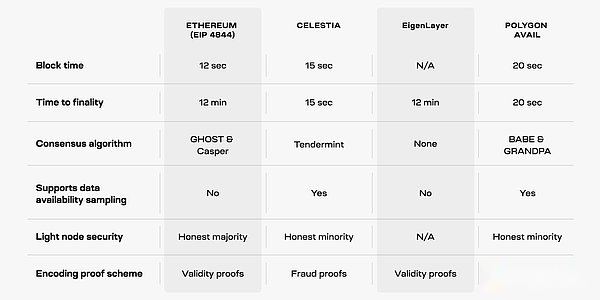
Photo source: Researcher@Likebeckett
Data availability is abbreviated as DA. At present, the overall upgrade route of Taifang is mainly Rollup. The role of DA in the process is used to save or upload all transaction data of the entire Rollup.The emergence of Rollup is to solve the scalability of Layer1, but the actual access to Layer2 data through DA will affect the overall security and TPS level.The mechanism is uploaded to a large amount of Layer2 data.
In the consensus mechanism, there is a fundamental dilemma, that is, effectiveness and security. The former ensures the rapid treatment of the transaction, and the latter to ensure the accuracy and security of the transaction. For this reason, different blockchain systems will do it.Different options to achieve a balance that meets its actual needs.Among them, Ethereum, Celestia, Eigenlayer, and Avail solutions are designed to provide scalable data availability for ROLLUP. According to the relevant data provided by Researcher@likebeckett and Avail, I made the following summary.
>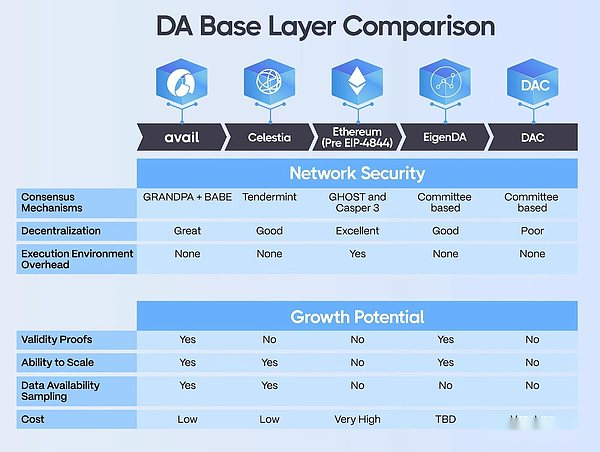
Picture source: avail team official
Celestia:
Decentralized sorter proposalTheCelestia discusses a solution to the decentralized sorter of CELESTIA by the CELESTIA’s decentralized sorter proposed by Celestia, which is proposed by the chief operating officer Nick White from the Cosmos Hub.Provide shared security;
Atomic cross -Rollup combination: Celestia can achieve atomic transactions between multiple ROLLUP networks by using ICS, thereby increasing combination.The same sorter enables multiple ROLLUP networks to work together to solve the problem of liquidity fragmentation and combined reduction;
Multi -ROLLUP interoperability: Using the same sorter, Celestia can promote the interoperability between multiple ROLLUP networks and achieve better liquidity and data availability.
Eigenlayer and EIGENDA:
Share security data availability service: Eigenlayer provides data availability services through EIGENDA. Unlike traditional blockchain, it is a set of smart contracts built on Ethereum to make full use of the concept of sharing security.EIGENDA can be used as part of the Celestia ecosystem, providing efficient, secure, scalable data availability;
Decentralized sorting: EIGENLAYER emphasizes its decentralized sorting mechanism. It is essentially adding ETH tokens and penalties to the LAYER 2 network to provide higher security in the POS process of the Rollup sorter.Through this mechanism, EIGENLAYER has achieved an efficient sorting process;
Data usability service: EIGENDA focuses on providing data availability services to Layer 2 networks. Through EIGENLAYER sharing security and decentralized sorting, it provides high -performance data transmission for applications on the chain.
Avail:
Data availability design: Avail focuses on the design of data availability and introduces data availability sampling technology.This technology allows light nodes to verify the availability of data by downloading only one part of the block, rather than relying on the entire node to obtain data, thereby improving the scalability of the network;
Blockchain interaction: Avail’s design aims to improve the interaction between blockchain.The light node that supports data availability sampling makes the size of the block more flexible and increases the overall throughput;
EIP 4844 Adaptability: Avail actively participates in the implementation of Ethereum’s EIP 4844. It is an important part of the Polygon modular blockchain vision. The proposal aims to increase the block size and lay the foundation for the implementation of Danksharnding, which enables Avail to adapt to EthereumEcological system upgrade.
Conclusion
For ROLLUP, in 24 years, in addition to the certainty narrative brought by the upgrade of Cancun, the debate of the DA problem also brings the problem of accurate positioning of Layer2.Do not talk about cost issues. This dispute between Celestia and EIGENDA is not difficult to lead to a thinking. Under the confrontation between the Ether killer and the Ether City Wall, it will cause more market competition in the direction of combined modules to make it allowA new round of flowers bloom in Ethereum expansion.
Although there are many limitations in the blockchain itself, from the perspective of the financial market, the majority of the rising momentum of all markets comes from the “imaginary space”, and there must be new stories to feed.In addition to maintaining its own correctness itself, the “left side of the door” is also a narrative direction that jumps out of the original framework.

